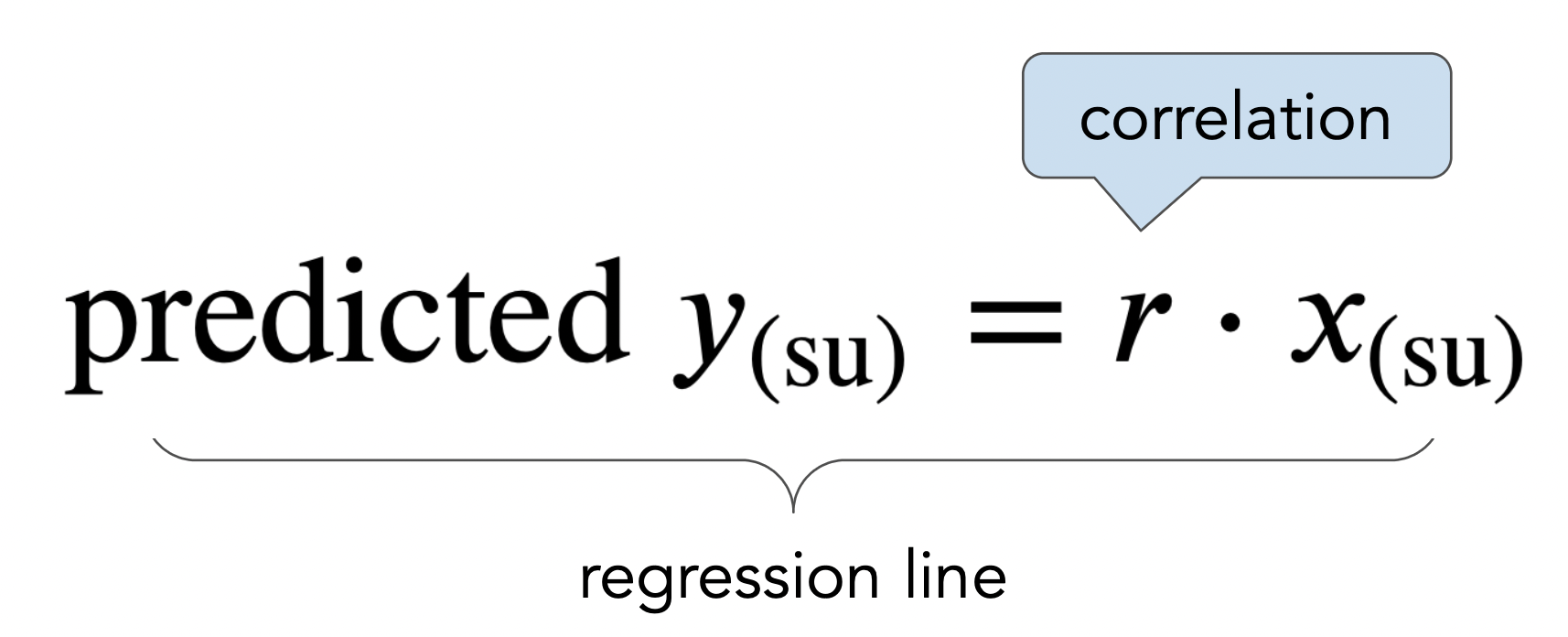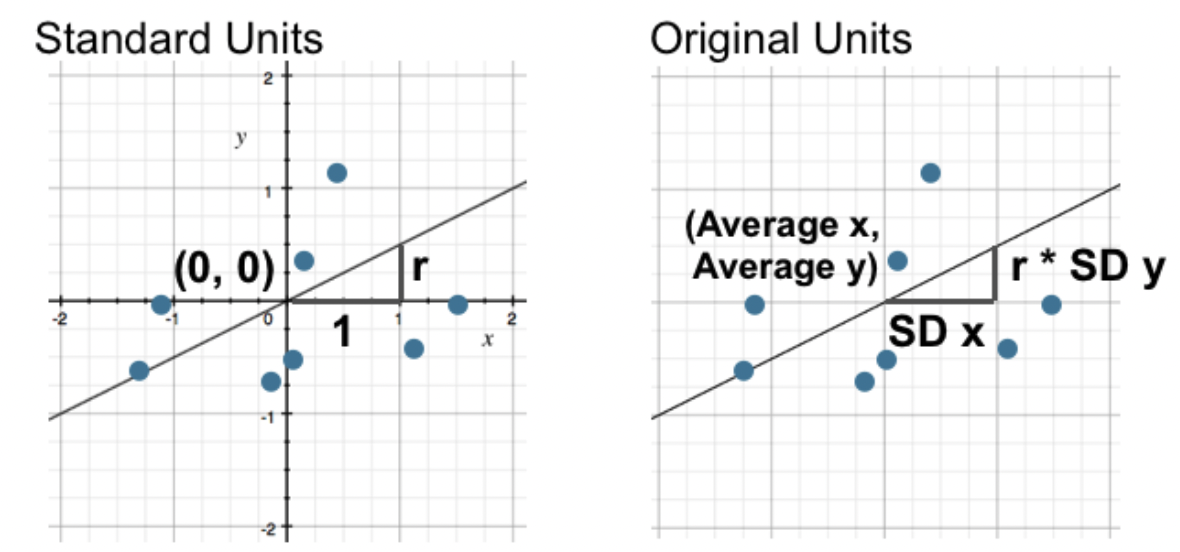The regression line¶
- The regression line is the line through $(0,0)$ with slope $r$, when both variables are measured in standard units.

- We use the regression line to make predictions!
# Set up packages for lecture. Don't worry about understanding this code, but
# make sure to run it if you're following along.
import numpy as np
import babypandas as bpd
import pandas as pd
from matplotlib_inline.backend_inline import set_matplotlib_formats
import matplotlib.pyplot as plt
from scipy import stats
set_matplotlib_formats("svg")
plt.style.use('ggplot')
np.set_printoptions(threshold=20, precision=2, suppress=True)
pd.set_option("display.max_rows", 7)
pd.set_option("display.max_columns", 8)
pd.set_option("display.precision", 2)
from ipywidgets import widgets
from IPython.display import clear_output, display
import warnings
warnings.filterwarnings('ignore')
# New minimize function (wrapper around scipy.optimize.minimize)
from inspect import signature
from scipy import optimize
def minimize(function):
n_args = len(signature(function).parameters)
initial = np.zeros(n_args)
return optimize.minimize(lambda x: function(*x), initial).x
# All of the following code is for visualization.
def plot_regression_line(df, x, y, margin=.02):
'''Computes the slope and intercept of the regression line between columns x and y in df (in original units) and plots it.'''
m = slope(df, x, y)
b = intercept(df, x, y)
df.plot(kind='scatter', x=x, y=y, s=100, figsize=(10, 5), label='original data')
left = df.get(x).min()*(1 - margin)
right = df.get(x).max()*(1 + margin)
domain = np.linspace(left, right, 10)
plt.plot(domain, m*domain + b, color='orange', label='regression line', lw=4)
plt.suptitle(format_equation(m, b), fontsize=18)
plt.legend();
def format_equation(m, b):
if b > 0:
return r'$y = %.2fx + %.2f$' % (m, b)
elif b == 0:
return r'$y = %.2fx' % m
else:
return r'$y = %.2fx %.2f$' % (m, b)
def plot_errors(df, m, b, ax=None):
x = df.get('x')
y = m * x + b
df.plot(kind='scatter', x='x', y='y', s=100, label='original data', ax=ax, figsize=(10, 5) if ax is None else None)
if ax:
plotter = ax
else:
plotter = plt
plotter.plot(x, y, color='orange', lw=4)
for k in np.arange(df.shape[0]):
xk = df.get('x').iloc[k]
yk = np.asarray(y)[k]
if k == df.shape[0] - 1:
plotter.plot([xk, xk], [yk, df.get('y').iloc[k]], linestyle=(0, (1, 1)), c='r', lw=4, label='errors')
else:
plotter.plot([xk, xk], [yk, df.get('y').iloc[k]], linestyle=(0, (1, 1)), c='r', lw=4)
plt.title(format_equation(m, b), fontsize=18)
plt.xlim(50, 90)
plt.ylim(40, 100)
plt.legend();
The Final Project is due on Tuesday 3/14 at 11:59 PM and has 8 sections. How much progress have you made?
A. Not started or barely started ⏳
B. Finished 1 or 2 sections
C. Finished 3 or 4 sections ❤️
D. Finished 5 or 6 sections
E. Finished 7 or 8 sections 🤯
Recall, in the last lecture, we aimed to use a mother's height to predict her adult son's height.
galton = bpd.read_csv('data/galton.csv')
male_children = galton[galton.get('gender') == 'male']
mom_son = bpd.DataFrame().assign(mom = male_children.get('mother'),
son = male_children.get('childHeight'))
mom_son
| mom | son | |
|---|---|---|
| 0 | 67.0 | 73.2 |
| 4 | 66.5 | 73.5 |
| 5 | 66.5 | 72.5 |
| ... | ... | ... |
| 925 | 60.0 | 66.0 |
| 929 | 66.0 | 64.0 |
| 932 | 63.0 | 66.5 |
481 rows × 2 columns
mom_son.plot(kind='scatter', x='mom', y='son', figsize=(10, 5));
Recall, the correlation coefficient $r$ of two variables $x$ and $y$ is defined as the
def standard_units(any_numbers):
"Convert a sequence of numbers to standard units."
return (any_numbers - any_numbers.mean()) / np.std(any_numbers)
def correlation(df, x, y):
"Computes the correlation between column x and column y of df."
return (standard_units(df.get(x)) * standard_units(df.get(y))).mean()
r_mom_son = correlation(mom_son, 'mom', 'son')
r_mom_son
0.32300498368490554


Of course, we'd like to be able to predict a son's height in inches, not just in standard units. Given a mother's height in inches, here's how we'll predict her son's height in inches:
mom_mean = mom_son.get('mom').mean()
mom_sd = np.std(mom_son.get('mom'))
son_mean = mom_son.get('son').mean()
son_sd = np.std(mom_son.get('son'))
def predict_with_r(mom):
"""Return a prediction for the height of a son whose mother has height mom,
using linear regression.
"""
mom_su = (mom - mom_mean) / mom_sd
son_su = r_mom_son * mom_su
return son_su * son_sd + son_mean
predict_with_r(68)
70.68219686848828
predict_with_r(60)
67.76170758654767
preds = mom_son.assign(
predicted_height=mom_son.get('mom').apply(predict_with_r)
)
ax = preds.plot(kind='scatter', x='mom', y='son', title='Regression line predictions, in original units', figsize=(10, 5), label='original data')
preds.plot(kind='line', x='mom', y='predicted_height', ax=ax, color='orange', label='regression line', lw=4);
plt.legend();
A course has a midterm (mean 80, standard deviation 15) and a really hard final (mean 50, standard deviation 12).
If the scatter plot comparing midterm & final scores for students looks linearly associated with correlation 0.75, then what is the predicted final exam score for a student who received a 90 on the midterm?
Each time we wanted to predict the height of an adult son given the height of a mother, we had to:
This is inconvenient – wouldn't it be great if we could express the regression line itself in inches?
When $x$ and $y$ are in standard units, the regression line is given by

What is the regression line when $x$ and $y$ are in their original units?

Let's implement these formulas in code and try them out.
def slope(df, x, y):
"Returns the slope of the regression line between columns x and y in df (in original units)."
r = correlation(df, x, y)
return r * np.std(df.get(y)) / np.std(df.get(x))
def intercept(df, x, y):
"Returns the intercept of the regression line between columns x and y in df (in original units)."
return df.get(y).mean() - slope(df, x, y) * df.get(x).mean()
Below, we compute the slope and intercept of the regression line between mothers' heights and sons' heights (in inches).
m_heights = slope(mom_son, 'mom', 'son')
m_heights
0.36506116024257595
b_heights = intercept(mom_son, 'mom', 'son')
b_heights
45.85803797199311
So, the regression line is
$$\text{predicted son's height} = 0.365 \cdot \text{mother's height} + 45.858$$def predict_son(mom):
return m_heights * mom + b_heights
What's the predicted height of a son whose mother is 62 inches tall?
predict_son(62)
68.49182990703282
What if the mother is 55 inches tall? 73 inches tall?
predict_son(55)
65.9364017853348
predict_son(73)
72.50750266970115
xs = np.arange(57, 72)
ys = predict_son(xs)
mom_son.plot(kind='scatter', x='mom', y='son', figsize=(10, 5), title='Regression line predictions, in original units', label='original data');
plt.plot(xs, ys, color='orange', lw=4, label='regression line')
plt.legend();
Consider the dataset below. What is the correlation between $x$ and $y$?
outlier = bpd.read_csv('data/outlier.csv')
outlier.plot(kind='scatter', x='x', y='y', s=100, figsize=(10, 5));
correlation(outlier, 'x', 'y')
-0.02793982443854457
plot_regression_line(outlier, 'x', 'y')
without_outlier = outlier[outlier.get('y') > 40]
correlation(without_outlier, 'x', 'y')
0.9851437295364016
plot_regression_line(without_outlier, 'x', 'y')
Takeaway: Even a single outlier can have a massive impact on the correlation, and hence the regression line. Look for these before performing regression. Always visualize first!
outlier.plot(kind='scatter', x='x', y='y', s=100, figsize=(10, 5));
m_no_outlier = slope(without_outlier, 'x', 'y')
b_no_outlier = intercept(without_outlier, 'x', 'y')
m_no_outlier, b_no_outlier
(0.975927715724588, 3.042337135297444)
plot_errors(without_outlier, m_no_outlier, b_no_outlier)
We think our regression line is pretty good because most data points are pretty close to the regression line. The red lines are quite short.
predictions = without_outlier.assign(pred=m_no_outlier * without_outlier.get('x') + b_no_outlier)
predictions = predictions.assign(diffs=predictions.get('y') - predictions.get('pred'))
predictions = predictions.assign(sq_diffs=predictions.get('diffs') ** 2)
predictions
| x | y | pred | diffs | sq_diffs | |
|---|---|---|---|---|---|
| 0 | 50 | 53.53 | 51.84 | 1.69 | 2.86 |
| 1 | 55 | 54.21 | 56.72 | -2.51 | 6.31 |
| 2 | 60 | 65.65 | 61.60 | 4.06 | 16.45 |
| ... | ... | ... | ... | ... | ... |
| 6 | 80 | 79.61 | 81.12 | -1.51 | 2.27 |
| 7 | 85 | 88.17 | 86.00 | 2.18 | 4.74 |
| 8 | 90 | 91.05 | 90.88 | 0.18 | 0.03 |
9 rows × 5 columns
np.sqrt(predictions.get('sq_diffs').mean())
2.19630831647554
The RMSE of the regression line's predictions is about 2.2. Is this big or small, relative to the predictions of other lines? 🤔
x using an arbitrary line defined by slope and intercept, compute x * slope + intercept.def rmse(slope, intercept):
'''Calculates the RMSE of the line with the given slope and intercept,
using the 'x' and 'y' columns of without_outlier.'''
# The true values of y.
true = without_outlier.get('y')
# The predicted values of y, from plugging the x values from the
# given DataFrame into the line with the given slope and intercept.
predicted = slope * without_outlier.get('x') + intercept
return np.sqrt(((true - predicted) ** 2).mean())
# Check that our function works on the regression line.
rmse(m_no_outlier, b_no_outlier)
2.19630831647554
Let's compute the RMSEs of several different lines on the same dataset.
# Experiment by changing one of these!
lines = [(1.2, -15), (0.75, 11.5), (-0.4, 100)]
fig, ax = plt.subplots(1, 3, figsize=(14, 4))
for i, line in enumerate(lines):
plt.subplot(1, 3, i + 1)
m, b = line
plot_errors(without_outlier, m, b, ax=ax[i])
ax[i].set_title(format_equation(m, b) + f'\nRMSE={np.round(rmse(m, b), 2)}')
minimize. minimize¶minimize takes in a function as an argument, and returns the inputs to the function that produce the smallest output. minimize can find this, too:def f(x):
return (x - 5) ** 2 + 4
minimize(f)
array([5.])
minimize function uses calculus and intelligent trial-and-error to find these inputs; you don't need to know how it works under the hood.We'll use minimize on rmse, to find the slope and intercept of the line with the smallest RMSE.
smallest_rmse_line = minimize(rmse)
smallest_rmse_line
array([0.98, 3.04])
m_smallest_rmse = smallest_rmse_line[0]
b_smallest_rmse = smallest_rmse_line[1]
Do these numbers look familiar?
# The slope and intercept with the smallest RMSE, from our call to minimize.
m_smallest_rmse, b_smallest_rmse
(0.9759274388041896, 3.0423565872406115)
# The slope and intercept according to our regression line formulas.
slope(without_outlier, 'x', 'y'), intercept(without_outlier, 'x', 'y')
(0.975927715724588, 3.042337135297444)
The slopes and intercepts we got using both approaches look awfully similar... 👀
What's the regression line for this dataset?
np.random.seed(23)
x2 = bpd.DataFrame().assign(
x=np.arange(-6, 6.1, 0.5) + np.random.normal(size=25),
y=np.arange(-6, 6.1, 0.5)**2 + np.random.normal(size=25)
)
x2.plot(kind='scatter', x='x', y='y', s=100, figsize=(10, 5));
plot_regression_line(x2, 'x', 'y')
This line doesn't fit the data at all!